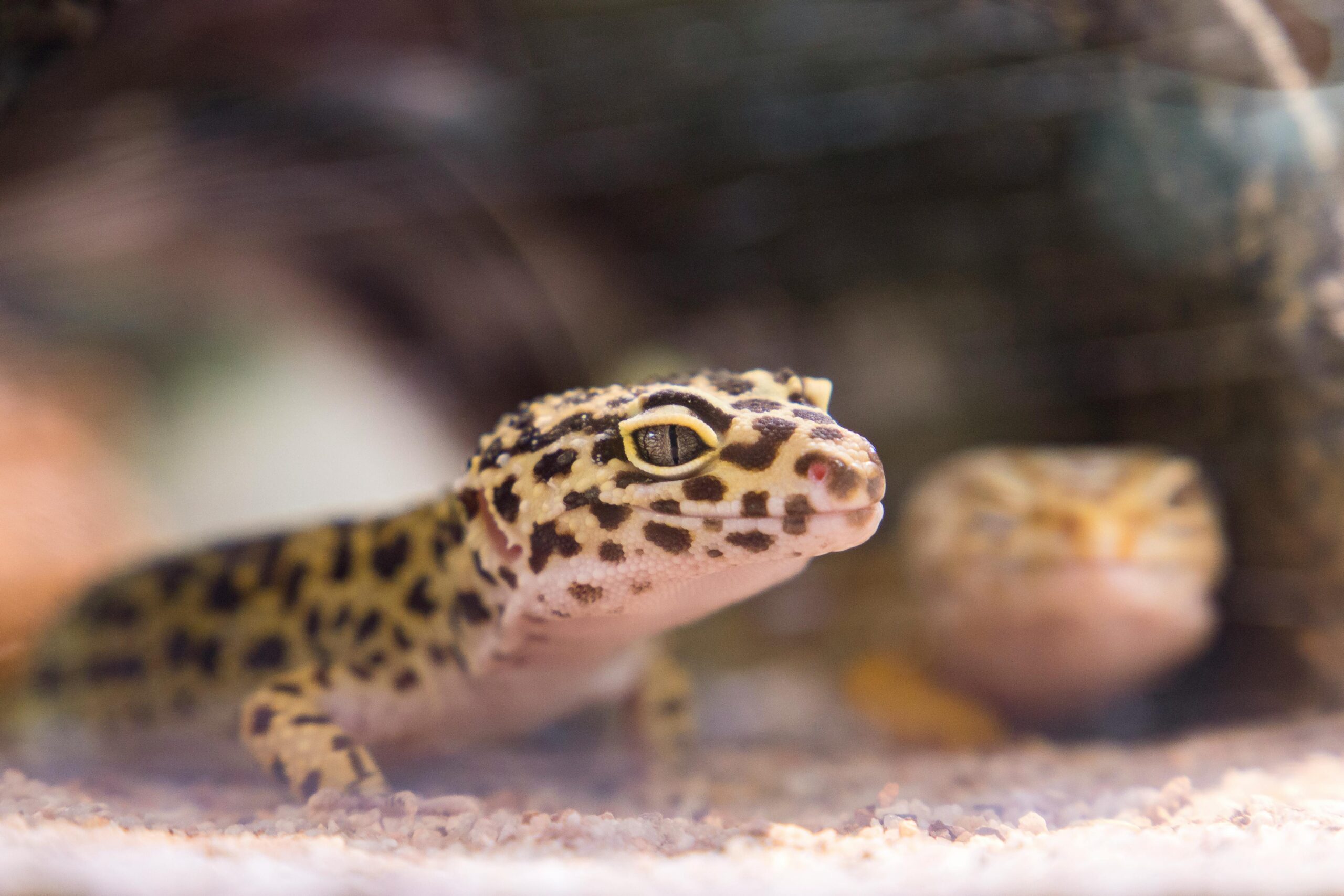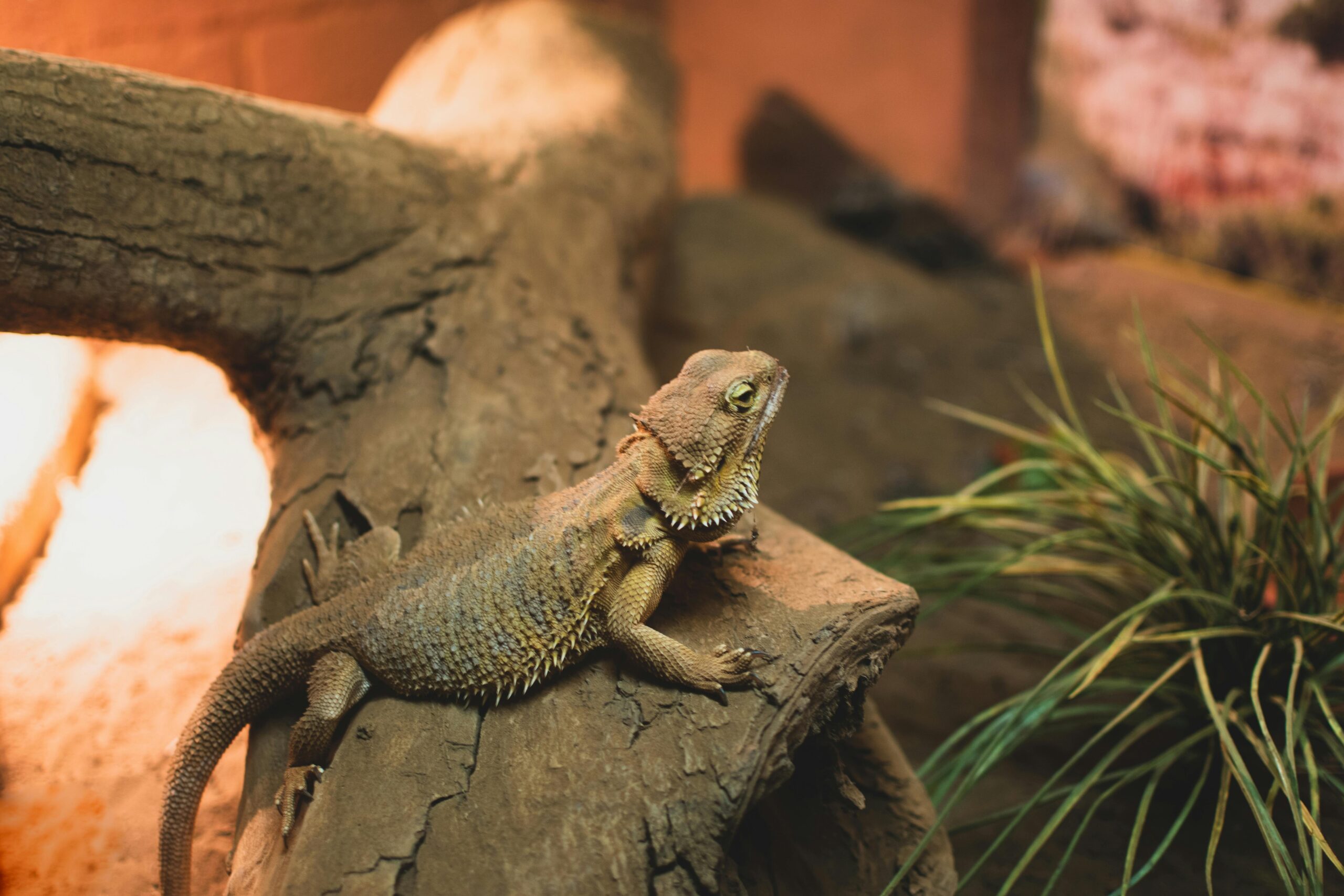Leopard Gecko Care Guide
Introduction:
Leopard geckos (Eublepharis macularius) are small (7–10″) ground-dwelling lizards with a stout body, bumpy skin, and a thick, segmented tail. Unlike many geckos, they have movable eyelids and cannot climb smooth walls. Wild-type geckos are pale yellow with black/brown spots, but captive-bred “morphs” come in a variety of colors. Native to semi-desert regions of Afghanistan, Pakistan, India, and Nepal, leopard geckos are adapted to arid, rocky terrain. With good care, they typically live 15–20 years. Their manageable size, docile temperament, and simple needs make them a popular choice for first-time reptile keepers.
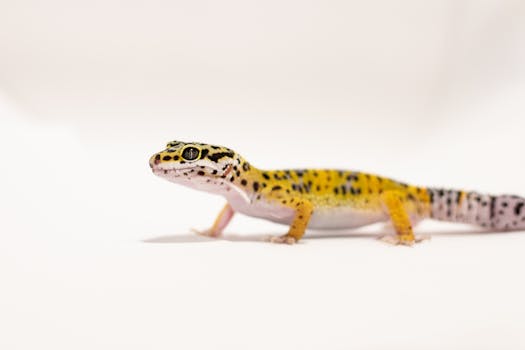
Leopard Gecko Enclosure Setup:
- Size & Shape: A single adult needs at least a 36″ × 18″ × 18″ (length × width × height) terrarium. Terrariums should be wider than tall since geckos are terrestrial. A front-opening glass terrarium (36″ × 18″ × 18″) is ideal for easy access.
- Hides: Provide at least two hide boxes – one on the warm side and one on the cool side. Geckos need secure hideouts to feel safe and thermoregulate. Place a flat rock or tile under the heat lamp to create a basking spot; the hide beneath it becomes the warm hide. Include another cool-side hide (the “humid hide”) filled with moist substrate for shedding.
- Decor: Use logs, rocks, branches and safe plants to enrich the environment. Arrange decorations to encourage gentle climbing and exploration. This provides exercise and mental stimulation.
- Social Housing: Most leopard geckos are best kept singly. If you do keep more than one (e.g. a male with several females), use a much larger enclosure and monitor carefully for aggression. Never house two adult males together – they will fight. Cohousing is not recommended for beginners.
- Cleaning: Spot-clean daily by removing feces and soiled substrate. Completely replace the substrate every 3–4 months to keep the habitat clean and prevent odors.
Advanced Keeper Tip: Use a front-opening terrarium with sliding doors. It makes feeding and maintenance easier, and limits escapes (leopard geckos cannot climb smooth glass, but they can squeeze through small gaps if curious).
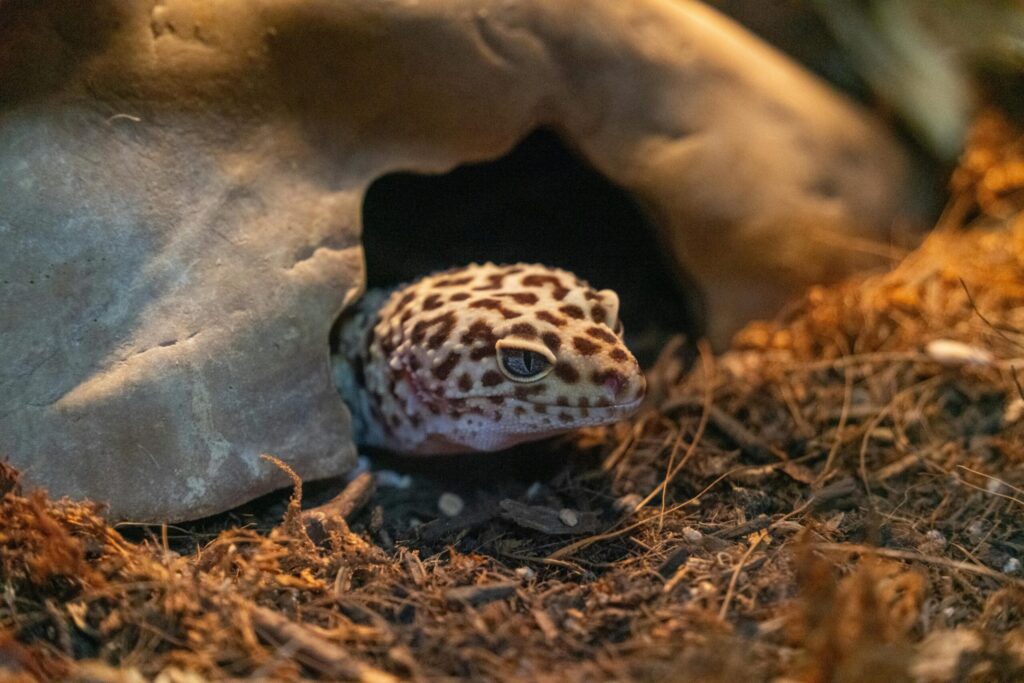
Leopard Gecko Substrate:
Selecting the right substrate is often debated. Any naturalistic, well-draining substrate is acceptable if the gecko is healthy, well-heated, and well-hydrated. Loose substrates (sands or mixes) can resemble the wild environment and allow burrowing. However, impaction risk should be considered (see Health Issues). Options include:
- DIY arid mix: 40% organic topsoil, 40% play sand, 20% Zoo Med Excavator clay.
- Commercial options: Lugarti Natural Reptile Bedding, Zoo Med ReptiSand, Exo Terra Desert Sand, or Bio Dude Terra Sahara.
Alternatively, safe substrates include slate tile, news paper, paper towels, or large flagstones – these greatly reduce impaction risk. Maintain hygiene by replacing it fully every few months and removing droppings daily.
Advanced Keeper Tip: Consider a partially bioactive setup: under a layer of safe substrate, introduce hide pods or cork bark structures. This can improve humidity retention (helpful for shedding) and keep the terrarium looking natural.
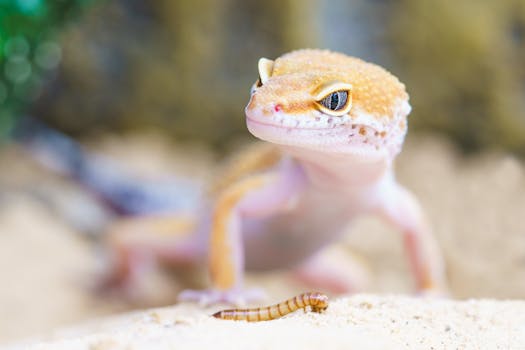
Heating, Temperature, and Lighting:
- Heat Source: Leopard geckos are ectothermic (cold-blooded), so they rely on external heat to regulate their body temperature. In captivity, a basking lamp (e.g. a 75–100W halogen bulb) is recommended to create a warm spot. Position the lamp over one end of the tank so that the basking surface reaches about 94–97°F (34–36°C). Place the lamp over mesh or a warm hide so the gecko can shelter under it. Use a dimmer or thermostat to fine-tune the output. Always monitor temperature with an infrared thermometer and/or probe.
- Temperature Gradient: Ensure a thermal gradient across the tank. The warm hide/basking area should be ~94–97°F, the warm hide interior ~90–92°F, and the cool side ~70–77°F. Nighttime can safely drop into the 60s °F.
- Lighting: Maintain a regular light cycle to mimic day/night. Use a bright white or full-spectrum lamp on a 12-hour timer. UVB lighting is not strictly required – leopard geckos can survive with vitamin-D3 supplements alone – but many keepers provide a low-level UVB tube (e.g. 5.0 T5 fluorescent) to promote natural behavior.
- Monitoring: Use digital thermometers and hygrometers to keep precise tabs on conditions.
Advanced Keeper Tip: For very accurate heat control, attach a thermostat probe directly inside the warm hide. Also, consider using a Solarmeter to measure the UV Index at the basking spot if you use UVB; aim for a UVI of ~1.0–2.0.
Leopard Gecko Humidity Requirements:
- Humidity: Leopard geckos originate from dry habitats, so they prefer a generally low-humidity environment. Aim for an average ambient humidity of ~30–40%. Provide a humid hide with substrate moistened to ~70–80% humidity. This promotes healthy shedding.
Advanced Keeper Tip: Use a digital hygrometer probe inside the humid hide to monitor moisture. Temporarily boost the hide’s humidity during shedding as needed.
Diet and Nutrition:
- Insectivorous Diet: Leopard geckos eat only insects. Offer a varied menu of gut-loaded live feeders: crickets, roaches, black soldier fly larvae, superworms, waxworms, hornworms, and silkworms.
- Feeding Schedule: Juveniles should be fed daily, young adults every 2–3 days, and fully-grown adults every 4–7 days. Remove uneaten prey after 15–30 minutes.
- Water: Provide a shallow dish of clean, fresh water at all times.
- Supplements: Dust live feeders with calcium powder at most feedings. Use calcium with vitamin D3 if no UVB is provided, or calcium without D3 if UVB is used. Offer a multivitamin once per week.
Advanced Keeper Tip: Gut-load your feeder insects 24 hours before feeding by giving them nutritious foods like leafy greens or a commercial insect gut-load formula.
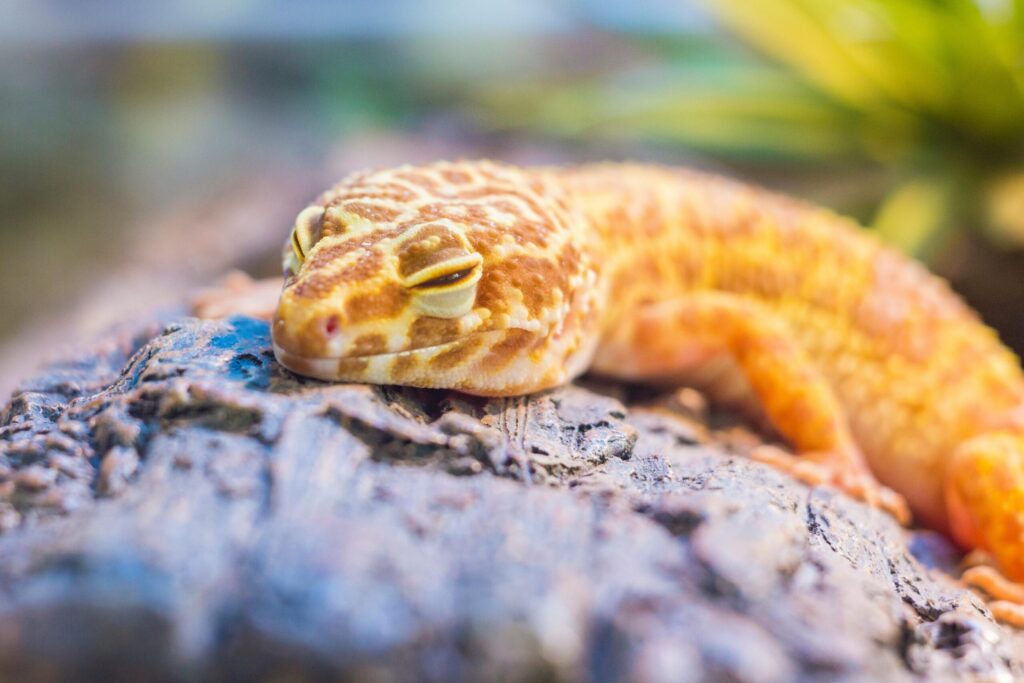
Common Health Issues and Mitigation:
- Metabolic Bone Disease (MBD): Caused by calcium or vitamin D₃ deficiency, leading to soft, deformed bones. Prevent with proper supplementation and UVB exposure if needed.
- Impaction: Blockage from swallowing substrate or large prey. Prevent by using safe substrates and feeding properly sized insects. At signs of impaction (bloated belly, lethargy), give warm soaks and seek vet care if unresolved.
- Respiratory Infection: Caused by cool or overly humid environments. Symptoms include wheezing, mucus, or open-mouth breathing. Prevent by maintaining appropriate temperatures and ventilation. Infections require veterinary antibiotics.
- Shedding Problems (Dysecdysis): Retained shed can constrict toes or tail. Prevent with a properly maintained humid hide. Assist stuck shed with warm soaks and gentle removal.
- Parasites: Parasites can cause diarrhea and weight loss. Quarantine new animals and have fecals tested by a vet. Treat infestations with prescription dewormers.
Advanced Keeper Tip: Have a reptile veterinarian’s contact info ready before problems arise. Quick response is critical in treating serious health issues.
Sources:
- Bartlett, R. D., and Patricia Bartlett. Leopard Geckos. Barron’s Educational Series, 2006.
- ReptiFiles. Leopard Gecko Care Sheet. 2020, https://reptifiles.com/wp-content/uploads/2020/10/Leopard-Gecko-Care-Sheet-PDF.pdf. Accessed 28 Apr. 2025.
- Stahl, Shelly. “Health Problems in Leopard Geckos.” VCA Animal Hospitals, https://vcahospitals.com/know-your-pet/leopard-geckos-health. Accessed 28 Apr. 2025.
- Mader, Douglas R., and Stephen J. Divers. Current Therapy in Reptile Medicine and Surgery. Saunders, 2014.
- Mitchell, Mark A., and Thomas N. Tully. Manual of Exotic Pet Practice. Saunders, 2008.
- Donoghue, Susan, and Robert L. Lyman. “Nutrition.” Reptile Medicine and Surgery, edited by Douglas R. Mader, 2nd ed., Saunders, 2006, pp. 251–298.
